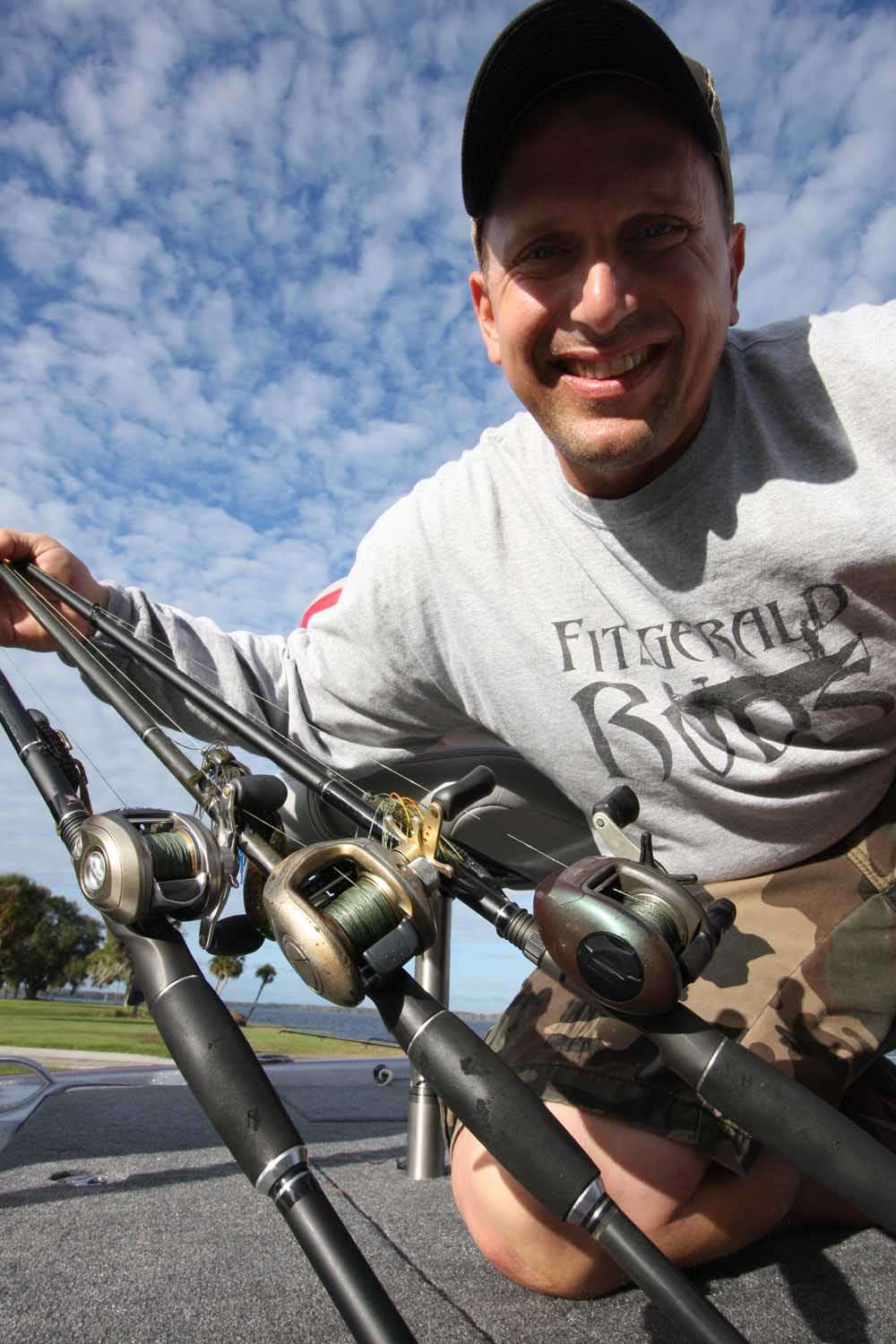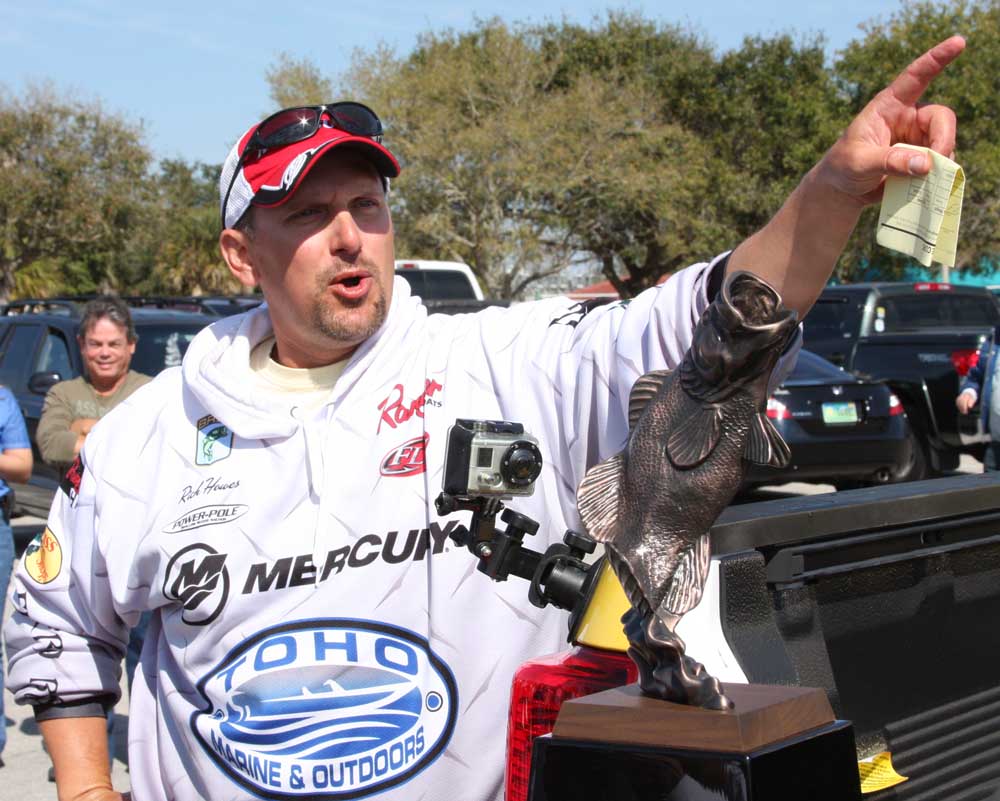
Living in Florida, I do a lot of pitching and punching in the heavy vegetation we have down here. It’s how I won the 2013 Bass Pro Shops Bassmaster Southern Open and earned a spot in the 2014 Bassmaster Classic.
For some anglers, pitching and punching may seem like similar tactics that use similar gear. But as someone who has worked hard to refine my pitching and punching, I can tell you that there are plenty of important differences and reasons I use different tools for each.
Let’s take them one at a time.
Pitching
If you’re not very familiar with pitching, it’s a close cousin of flippin’. The difference is that flippin’ is a fixed-line technique whereas pitching involves a very precise underhanded cast in which line is actually coming off your spool.
When selecting a good pitching rod, the first thing you’re looking for is length and action. For me, the perfect pitching rod is a 7 1/2-foot long heavy action model from Fitzgerald Rods. It’s lightweight, but extremely strong and sensitive. I can fish with it all day long without tiring. The tip has a little give to it, which is important for pitching accuracy. If you’re not hitting targets at 25 feet that are about the size of a coffee cup, you’re missing fish.
I’ll pitch to most types of cover, from laydowns to hydrilla lines to lily pads and boat docks. These are targets that offer some open water where you can place a lure like a jig, worm, craw or beaver-style bait. Most of my offerings weigh between 1/4- and 1 1/4-ounce. For anything heavier than that, I’ll go to my punching rod.
For most of my pitching, I use line ranging from 17-pound-test fluorocarbon to 65-pound-test Bass Pro Shops XPS 8 Advanced Braid, depending on the density of the cover and color of the water. If the cover’s heavy or the water’s dirty, I’ll usually bump up the size of my line. Generally, if I think I can get away with braid I’ll use it — I love the extra strength. And I don’t use a leader when I fish braid. After all, the weakest part of your connection to a fish is your knot, and leaders add knots.
When it comes to pitching reels, I like the Lew’s Tournament Pro Speed Spool with a 7.1:1 gear ratio. It’s got a great drag, is extremely strong and takes up a lot of line quickly so I can make a lot of presentations. That’s very important in a pitching or punching reel.
Punching
The punching technique probably originated here in Florida, where we get a lot of matted vegetation like hydrilla and hyacinths. It takes a heavy bait or sinker (usually 1 1/4-ounce and up) to penetrate the dense cover that big bass live under, and that requires some very heavy gear.
My punching rod is a Fitzgerald Rods Heavy Mat Flippin’ Rod that’s 7 feet, 10-inches long with an extra heavy action. I joke that it’s like fishing with a 2X4, but that’s not quite true. There is some action in the tip, but it’s a super stout rod and there’s good reason for that. I use the same Lew’s reel for punching, but I spool it up with 65-pound Bass Pro Shops XPS 8 Advanced Braid.
If you haven’t done a lot of punching, that might sound like gear for offshore marlin fishing, but I promise you that you’ll want all of that muscle and every possible advantage if you hook a big bass under a heavy mat.
When selecting your sinker for punching, the key is to use something heavy enough to get the bait through the mat and into the water beneath it. If your bait is simply landing on top of the mat and not pushing through, you’re wasting your time and need a heavier sinker. I’ve gone as heavy as 2 1/2 ounces. A small profile bait like the Gambler BB Cricket will help, too. It’s small, streamlined and penetrates cover easily. A lure with lots of appendages only makes it tough for the sinker to pull it through the cover.

I like the extra length and extra heavy action of the Fitzgerald Heavy Mat Flippin’ Rod for a couple of reasons.
First of all, the long rod gives you better leverage, which is critical when you set the hook and try to move the fish up and out of mat. Because your line is reaching out and then turning straight down in the cover, you don’t have a straight line between you and the fish. You have to take out that excess line quickly to get a good hook-set, and a long rod helps.
Second, the extra heavy action rod is essential when you’re fishing sinkers so heavy they’re usually thought of as surfcasting weights. Those things can wear you out in just an hour or two if your rod is too light for the job.
Finally, the big rod is essential for making the long pitches that are sometimes necessary to catch bass in mats. My co-anglers and fishing partners are often shocked at how far back into the densest, nastiest stuff I’ll pitch a lure. It’s true that I might not be able to get a good bass out of there and back to the boat, but you’ll never catch a fish you don’t cast to and the heavy gear gives me a fighting chance.
And that brings up a real key to punching that a lot of beginners miss: when you get a strike, set the hook fast, set the hook hard and get that fish up and on top of the mat as quickly as possible. Your goal is to get the fish’s head on top of the mat right away so you can surf it to the boat. If the fish is too big for that, get her pinned against the cover and go to her with your boat.
Once you master punching, you’ll be catching bass that most anglers never reach. Just be sure you’ve got enough rod!
Editor’s Note: Rich Howes is using his Bassmaster Classic appearance as an opportunity to support Fishing for the Kids and The Paley Foundation, organizations dedicated to helping children born with limb deficiencies. If you’d like to support the cause, you can make a donation or pledge an amount based on how many bass Rich weighs in at the Classic.




